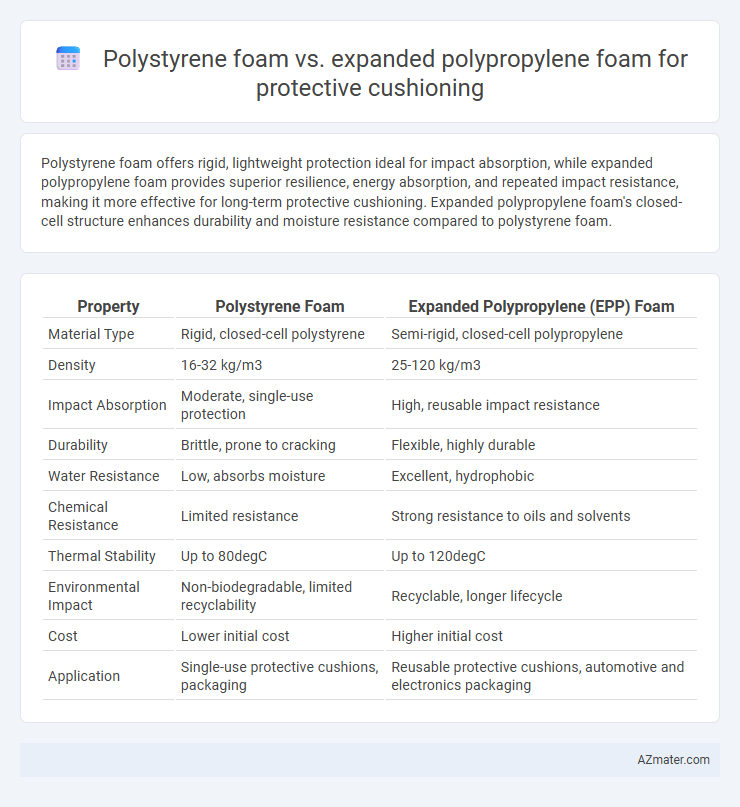Polystyrene foam offers rigid, lightweight protection ideal for impact absorption, while expanded polypropylene foam provides superior resilience, energy absorption, and repeated impact resistance, making it more effective for long-term protective cushioning. Expanded polypropylene foam's closed-cell structure enhances durability and moisture resistance compared to polystyrene foam.
Table of Comparison
| Property | Polystyrene Foam | Expanded Polypropylene (EPP) Foam |
|---|---|---|
| Material Type | Rigid, closed-cell polystyrene | Semi-rigid, closed-cell polypropylene |
| Density | 16-32 kg/m3 | 25-120 kg/m3 |
| Impact Absorption | Moderate, single-use protection | High, reusable impact resistance |
| Durability | Brittle, prone to cracking | Flexible, highly durable |
| Water Resistance | Low, absorbs moisture | Excellent, hydrophobic |
| Chemical Resistance | Limited resistance | Strong resistance to oils and solvents |
| Thermal Stability | Up to 80degC | Up to 120degC |
| Environmental Impact | Non-biodegradable, limited recyclability | Recyclable, longer lifecycle |
| Cost | Lower initial cost | Higher initial cost |
| Application | Single-use protective cushions, packaging | Reusable protective cushions, automotive and electronics packaging |
Introduction to Protective Cushion Foams
Protective cushion foams such as Polystyrene foam and Expanded Polypropylene (EPP) foam are widely used for impact absorption and packaging safety. Polystyrene foam offers lightweight and rigid properties ideal for single-use applications, while Expanded Polypropylene foam delivers superior durability, flexibility, and repeated impact resistance, making it suitable for reusable protective cushioning. The choice between these materials depends on factors like energy absorption capacity, environmental impact, and cost-effectiveness in specific protective cushioning applications.
What is Polystyrene Foam?
Polystyrene foam is a lightweight, rigid material commonly used for protective cushioning due to its excellent shock absorption and thermal insulation properties. It is made from expanded polystyrene beads, which create a closed-cell structure that absorbs impact energy and prevents damage during transportation or handling. Compared to expanded polypropylene foam, polystyrene foam offers higher stiffness but is less flexible and more brittle under stress.
What is Expanded Polypropylene (EPP) Foam?
Expanded Polypropylene (EPP) foam is a highly durable, lightweight, and recyclable material known for its exceptional energy absorption and impact resistance, making it ideal for protective cushioning applications. Unlike Polystyrene foam, EPP foam offers superior flexibility and resilience, allowing it to withstand multiple impacts without significant deformation. Its closed-cell structure enhances thermal insulation and moisture resistance, increasing its effectiveness in packaging and protective gear.
Material Properties: Polystyrene vs EPP
Polystyrene foam offers rigid structure and excellent shock absorption with low density, making it ideal for single-use protective cushioning where impact resistance is critical. Expanded polypropylene (EPP) foam provides superior flexibility, higher energy absorption, and excellent recovery after compression, enhancing durability for repeated impacts in protective applications. EPP's closed-cell structure ensures better moisture resistance and thermal insulation compared to polystyrene, improving overall protective performance in diverse environments.
Impact Absorption: Which Performs Better?
Expanded polypropylene (EPP) foam offers superior impact absorption compared to polystyrene (EPS) foam due to its higher resilience and ability to recover shape after compression, reducing the risk of permanent deformation. EPS foam dissipates energy through brittle cracking and is less effective for repetitive impact protection. The enhanced energy absorption and durability of EPP foam make it the preferred choice for protective cushions requiring reliable shock mitigation.
Durability and Longevity Comparison
Expanded polypropylene (EPP) foam demonstrates superior durability and longevity compared to polystyrene foam due to its enhanced energy absorption and resistance to repeated compressions without significant deformation. EPP's closed-cell structure provides excellent impact resistance and recovers its shape better over time, making it ideal for long-term protective cushioning applications. In contrast, polystyrene foam tends to crack and degrade after multiple impacts, leading to reduced protective performance and shorter lifespan.
Environmental Impact and Recyclability
Polystyrene foam, commonly used for protective cushioning, poses significant environmental challenges due to its non-biodegradable nature and difficulties in recycling, often ending up in landfills or oceans where it persists for centuries. Expanded polypropylene (EPP) foam offers a more eco-friendly alternative, being lightweight, highly durable, and recyclable through mechanical grinding and reprocessing, reducing waste and environmental footprint. EPP foam's ability to withstand multiple recycling cycles without significant loss in cushioning performance further enhances its sustainability in protective packaging applications.
Weight and Flexibility in Application
Polystyrene foam weighs significantly less than expanded polypropylene foam, making it ideal for applications where minimal weight is crucial. Expanded polypropylene foam offers superior flexibility and durability, enhancing protective cushioning by absorbing repeated impacts without permanent deformation. In applications requiring both weight efficiency and adaptability to dynamic forces, expanded polypropylene foam provides a more reliable performance despite its higher density.
Cost Analysis: Polystyrene vs EPP Foam
Polystyrene foam typically offers a lower upfront cost compared to Expanded Polypropylene (EPP) foam, making it a more budget-friendly option for protective cushioning in applications with limited budgets. However, EPP foam's superior durability and reusability can lead to lower lifecycle costs by reducing replacement frequency and material waste. Cost analysis must consider initial purchase price alongside long-term savings, as EPP's resilience often justifies the higher initial expenditure in high-impact or reusable packaging scenarios.
Conclusion: Choosing the Right Foam for Protective Cushioning
Expanded polypropylene (EPP) foam offers superior impact resistance, durability, and lightweight properties compared to polystyrene foam, making it ideal for high-performance protective cushioning. Polystyrene foam is cost-effective and provides adequate shock absorption but lacks the resilience and reusability found in EPP foam. Selecting the right material depends on balancing budget constraints with the need for long-term protection and environmental sustainability.

Infographic: Polystyrene foam vs Expanded polypropylene foam for Protective Cushion
 azmater.com
azmater.com